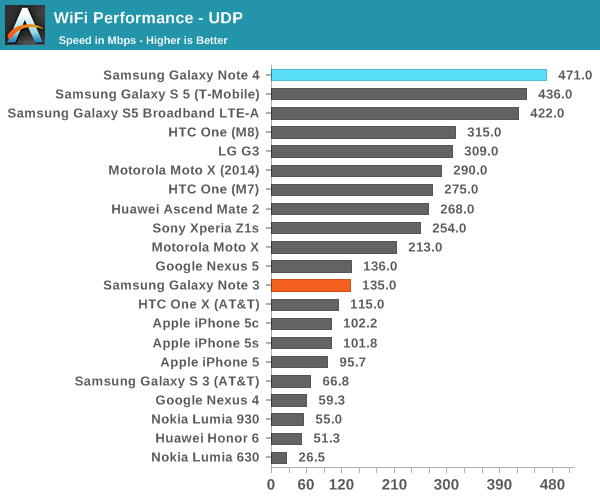The Samsung Galaxy Note 4 Review
by Joshua Ho on October 15, 2014 9:00 AM EST- Posted in
- Smartphones
- Samsung
- Android
- Mobile
- Galaxy Note 4
WiFi Performance
While the Galaxy S5 LTE-A Broadband had a Qualcomm Atheros solution (QCA6174), the Note 4 moves back to Broadcom's WiFi solution. In this case, we see the BCM4358, which is a revision of the BCM4354 that was first seen with Samsung's Galaxy S5. This shouldn't have any major differences outside of improved Bluetooth coexistence but antenna design can and does change between revisions. In order to test this, we use iperf and Asus' RT-AC68U router to try and achieve maximum performance.

As one can see, the Galaxy Note 4 has a strong showing in this test, easily surpassing every other device we have available for testing.
GNSS
At this point, it really goes without saying that the GNSS solution of choice is the one built into Qualcomm's modem. This allows for fixes based upon initial location and time data that the modem has, and therefore in practice every GPS fix is a hot fix and takes around 5 seconds for a lock in good conditions. In the case of the Note 4, with airplane mode on and no assistance data I saw that it took around 50 seconds to achieve a lock, but this is strongly dependent upon environmental conditions. Once locked, I found that the Note 4 had quite a strong lock and quickly went down to 10 foot accuracy level without issue.
Misc
Similar to the new Moto X we see a Cypress CapSense solution in the Note 4 but this is likely used for the capacitive buttons rather than any impedance-matching antenna tuner. The UV sensor appears to be a Maxim design win, although there's no information on the specific part. The battery's fuel gauge is also a Maxim part, as is the speaker amplifier and pulse sensor. The NFC chip used is NXP's PN547, so host card emulation should be supported and therefore Google Wallet's tap and pay system should work as well.











195 Comments
View All Comments
theduckofdeath - Wednesday, October 15, 2014 - link
I think this is a US centric site and the Exynos variant will probably never be on sale in the US.gunsman - Wednesday, October 15, 2014 - link
Will you guys be getting the international version of this as well? Would love to see performance of A57/A53 compared to the 805. Would also love to see comparison of ARMv7 A57/A53 to (when it comes out) ARMv8 enabled A57/A53 to see benefits of new instruction sets and 64 bitmayankleoboy1 - Wednesday, October 15, 2014 - link
thisMost important think about the Note4 is the Exynos 5433 SOC, which is on the 20nm node. Snapdragon 805 is a known entity.
mpokwsths - Wednesday, October 15, 2014 - link
@JoshHo: You do know that the NAND performance measurements and comparisons between different OS and benchmark programs is not accurate, right? I own a Nexus 5 which, with Android L preview, achieves more than double the performance figures than with Kitkat. That same has been observed with other Android L devices: http://forum.xda-developers.com/nexus-7-2013/gener...I'm saying this because of the misleading graphs you provide, showing the iphones miles ahead of Kitkat android devices. Well, they are NOT. They are just on a different OS / benchmark. Iphones should be removed from the graph ASAP, or include some Android L preview measurements as well. Otherwise, the NAND performance graphs are highly misleading.
JoshHo - Wednesday, October 15, 2014 - link
I don't have any particular reason to suspect Androbench pre-Android L, but I would expect some sort of compatibility issue with Androbench and Android L dev preview.NAND performance is generally not OS-dependent.
mpokwsths - Wednesday, October 15, 2014 - link
OS AND bench programI would expect a great amount of optimizations in the fs layer / kernel i/o scheduler and caching departments, together with newer controller device drivers of Android L. To make things simple: What if the compatibility issue of Androbench is with Kitkat and only with Android L will the true performance numbers show?
We will know soon enough...
Ortanon - Wednesday, October 15, 2014 - link
LOL What are you talking about? The Galaxy Note 4 is a package of hardware and software. Your Nexus 5 has Android L Preview on it; The Galaxy Note 4 does not. It gets the benchmark rating that it gets, and the iPhone gets the rating that it gets.mpokwsths - Wednesday, October 15, 2014 - link
whatever....uhuznaa - Wednesday, October 15, 2014 - link
What's wrong with testing devices with the OS that they're actually delivered with? After all it's the performance you'll see in actual use.KPOM - Wednesday, October 15, 2014 - link
We all know that the first thing the average consumer does is root the phone and install a bootleg version of the OS.